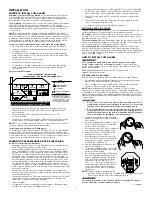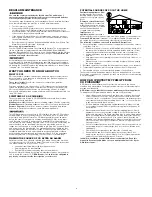
6
This Smoke/CO Alarm is intended for residential use. It is not intended for use
in industrial applications where Occupational Safety and Health Administration
(OSHA) requirements for Carbon Monoxide Alarms must be met. The Smoke
Alarm portion of this device is not intended to alert hearing impaired residents.
Special purpose Smoke Alarms should be installed for hearing impaired resi-
dents (CO Alarms are not yet available for the hearing impaired).
Smoke/CO Alarms cannot work without power.
Battery operated units cannot
work if the batteries are missing, disconnected or dead, if the wrong type of bat-
teries are used, or if the batteries are not installed correctly. AC units cannot
work if the AC power is cut off for any reason (open fuse or circuit breaker, failure
along a power line or at a power station, electrical fire that burns the electrical
wires, etc.). If you are concerned about the limitations of battery or AC power,
install both types of units.
This Smoke/CO Alarm will not sense smoke or CO that does not reach
the sensors.
It will only sense smoke or CO at the sensor. Smoke or CO may
be present in other areas. Doors or other obstructions may affect the rate at
which CO or smoke reaches the sensors. If bedroom doors are usually closed
at night, we recommend you install an alarm device (Combination CO and
Smoke Alarm, or separate CO Alarms and Smoke Alarms) in each bedroom
and in the hallway between them.
This Smoke/CO Alarm may not sense smoke or CO on another level of
the home.
Example: This alarm device, installed on the second floor, may not
sense smoke or CO in the basement. For this reason, one alarm device may
not give adequate early warning. Recommended minimum protection is one
alarm device in every sleeping area, every bedroom, and on every level of your
home. Some experts recommend battery powered Smoke and CO Alarms be
used in conjunction with interconnected AC powered Smoke Alarms. For
details, see “About Smoke Alarms” for details.
Smoke/CO Alarms may not be heard.
The alarm horn loudness meets or
exceeds current UL standards of 85 dB at 10 feet. However, if the Smoke/CO
Alarm is installed outside the bedroom, it may not wake up a sound sleeper or
one who has recently used drugs or has been drinking alcoholic beverages.
This is especially true if the door is closed or only partly open. Even persons
who are awake may not hear the alarm horn if the sound is blocked by dis-
tance or closed doors. Noise from traffic, stereo, radio, television, air condi-
tioner, or other appliances may also prevent alert persons from hearing the
alarm horn. This Smoke/CO Alarm is not intended for people who are hearing
impaired.
The Alarm may not have time to alarm before the fire itself causes
damage, injury, or death, since smoke from some fires may not reach the
unit immediately. Examples of this include persons smoking in bed, chil-
dren playing with matches, or fires caused by violent explosions resulting
from escaping gas.
This Smoke/CO Alarm is not a substitute for life insurance.
Though this
Smoke/CO Alarm warns against increasing CO levels or the presence of
smoke, BRK Brands, Inc. does not warrant or imply in any way that they will
protect lives. Homeowners and renters must still insure their lives.
This Smoke/CO Alarm has a limited life.
Although this Smoke/CO Alarm
and all of its parts have passed many stringent tests and are designed to be
as reliable as possible, any of these parts could fail at any time. Therefore, you
must test this device weekly. The unit should be replaced immediately if it is
not operating properly.
This Smoke/CO Alarm is not foolproof.
Like all other electronic devices, this
Smoke/CO Alarm has limitations. It can only detect smoke or CO that reaches
the sensors. It may not give early warning of the source of smoke or CO is in a
remote part of the home, away from the alarm device.
GENERAL LIMITATIONS OF SMOKE/CO ALARMS
SPECIAL COMPLIANCE CONSIDERATIONS
This unit alone is not a suitable substitute for complete fire detection sys-
tems in places housing many people—like apartment buildings, condo-
miniums, hotels, motels, dormitories, hospitals, long-term health care
facilities, nursing homes, day care facilities, or group homes of any
kind—even if they were once single-family homes. It is not a suitable sub-
stitute for complete fire detection systems in warehouses, industrial facil-
ities, commercial buildings, and special-purpose non-residential buildings
which require special fire detection and alarm systems. Depending on the
building codes in your area, this unit may be used to provide additional
protection in these facilities.
The following information applies to all five types of buildings listed below:
In new construction, most building codes require the use of AC or AC/DC pow-
ered Smoke Alarms only. AC, AC/DC, or DC powered Smoke Alarms can be
used in existing construction as specified by local building codes. Refer to NFPA
72 (National Fire Alarm Code) and NFPA 101 (Life Safety Code), local building
codes, or consult your Fire Department for detailed fire protection requirements in
buildings not defined as “households.”
1. Single-Family Residence:
Single family home, townhouse. It is recom-
mended this unit be installed on every level of the home, in every bedroom,
and in each bedroom hallway.
2. Multi-Family or Mixed Occupant Residence:
Apartment building, condominium. This unit is suitable for use in individual
apartments or condos, provided a primary fire detection system already exists
to meet fire detection requirements in common areas like lobbies, hallways, or
porches. Using this unit in common areas may not provide sufficient warning
to all residents or meet local fire protection ordinances/regulations.
3. Institutions:
Hospitals, day care facilities, long-term health care facilities.
This unit is suitable for use in individual patient sleeping/resident rooms, pro-
vided a primary fire detection system already exists to meet fire detection
requirements in common areas like lobbies, hallways, or porches. Using this
unit in common areas may not provide sufficient warning to all residents or
meet local fire protection ordinances/regulations.
4. Hotels and Motels:
Also boarding houses and dormitories. This unit is
suitable for use inside individual sleeping/resident rooms, provided a primary
fire detection system already exists to meet fire detection requirements in
common areas like lobbies, hallways, or porches. Using this unit in common
areas may not provide sufficient warning to all residents or meet local fire
protection ordinances/regulations.
5. Warehouses/Commercial Buildings:
DO NOT use this Smoke/CO Alarm in
warehouses, industrial or commercial buildings, special-purpose non-residen-
tial buildings, RVs, boats, or airplanes. This Smoke/CO Alarm is specifically
designed for residential use, and may not provide adequate protection in non-
residential applications.







